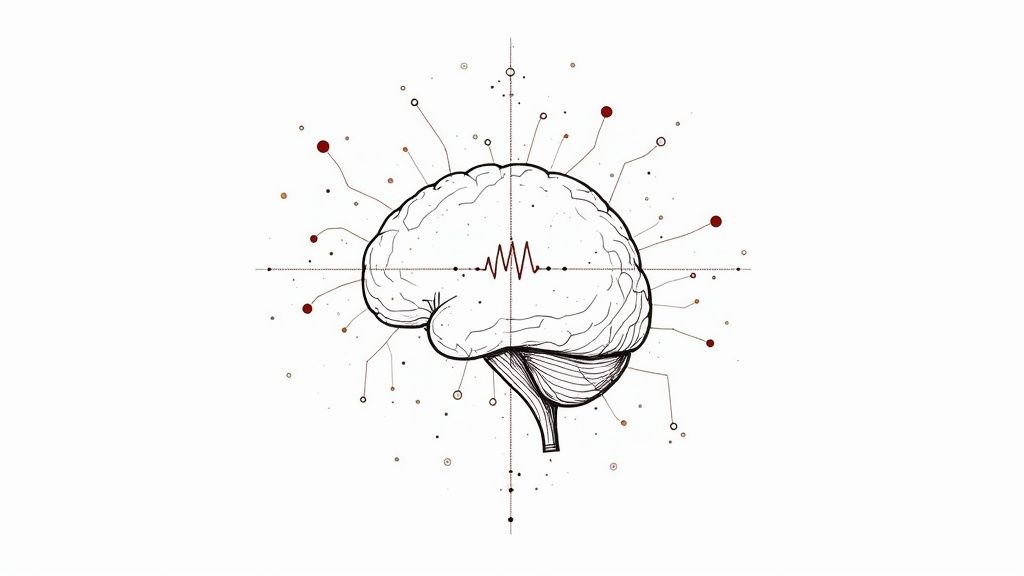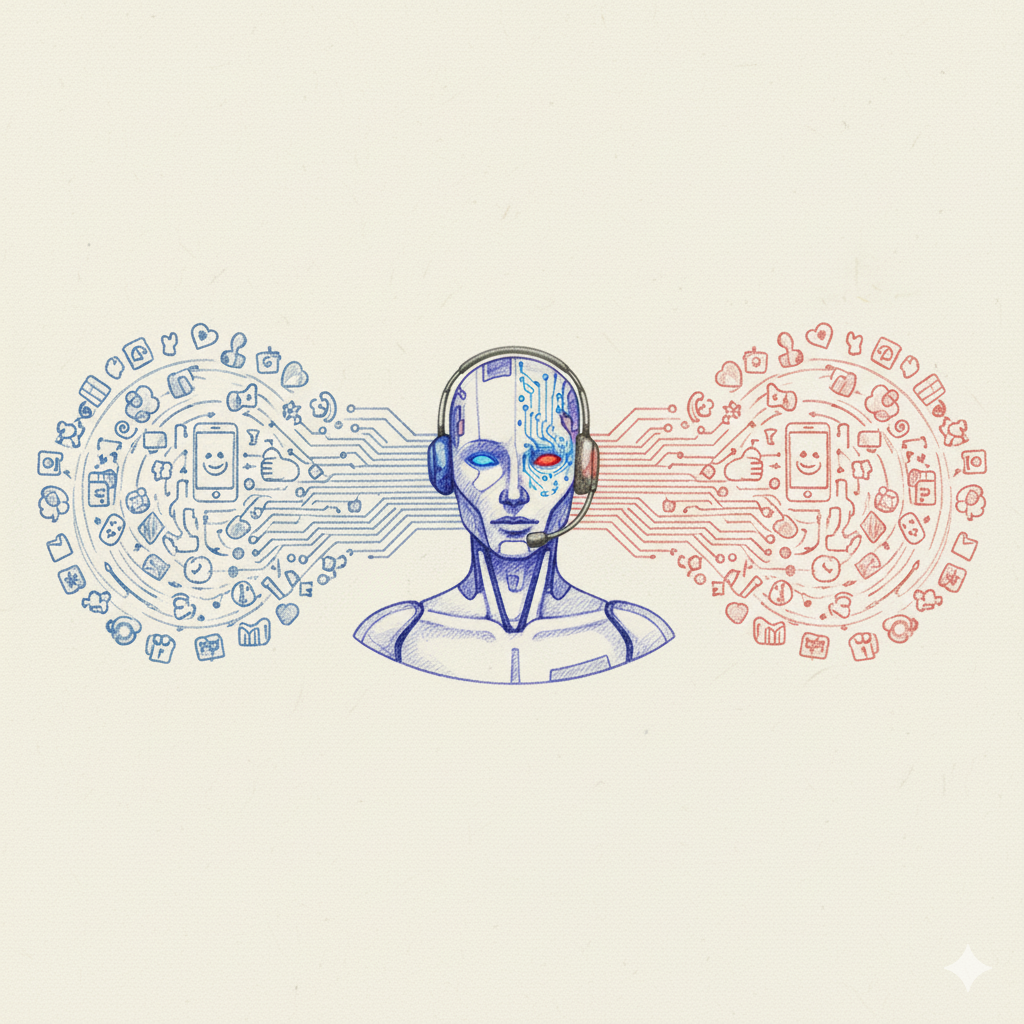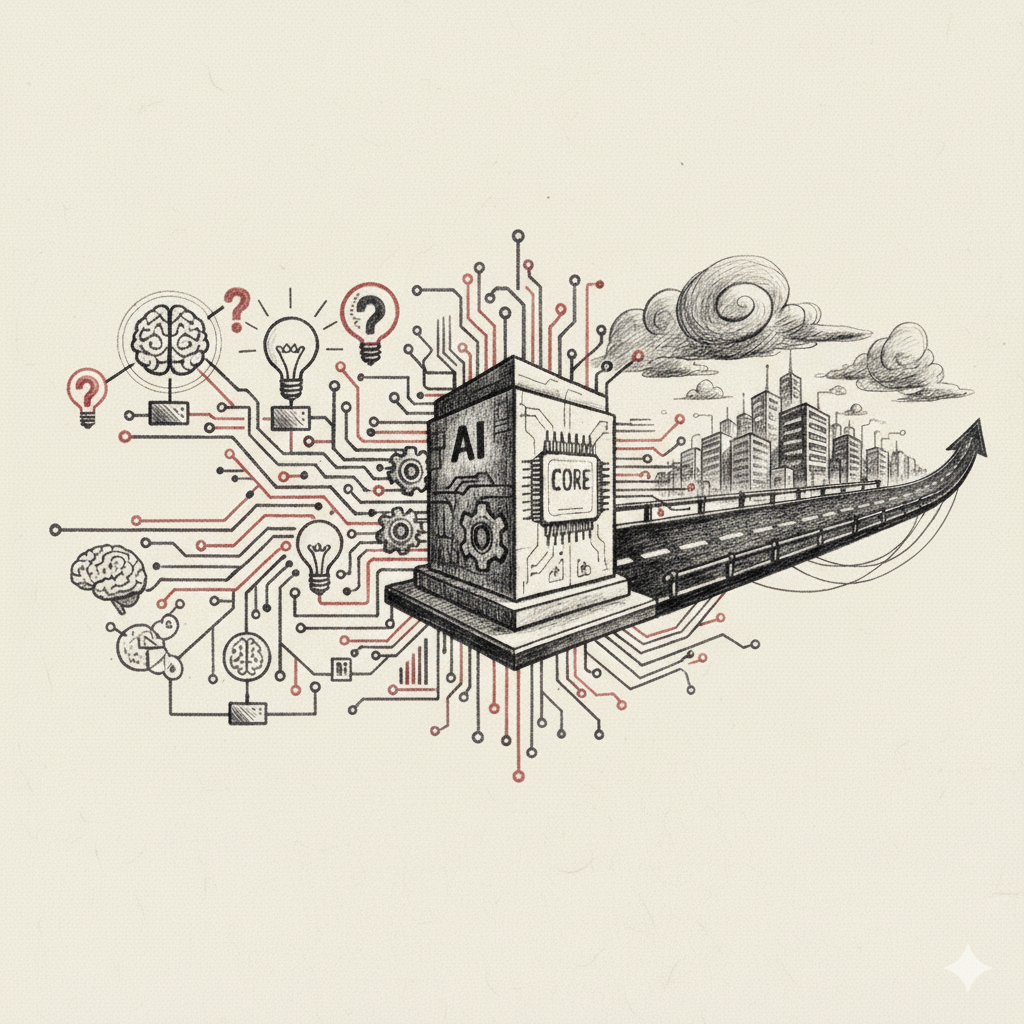Generative AI for Healthcare Uncovered
Explore how generative AI for healthcare is revolutionizing patient care, drug discovery, and operations. Learn the benefits, risks, and how to implement it.
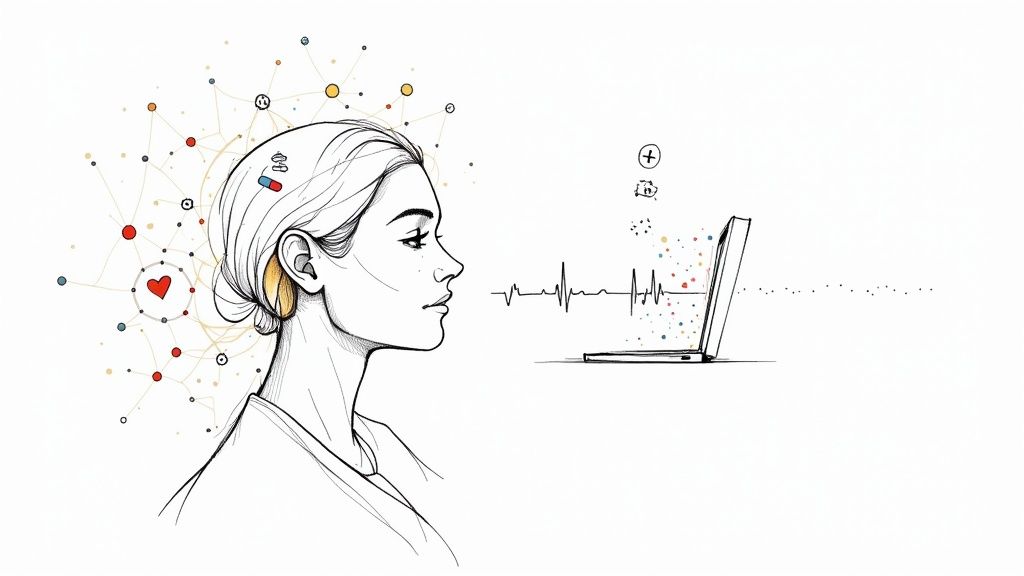
Generative AI in healthcare isn't just about analyzing data that already exists. It’s about creating entirely new and original content—things like clinical notes, patient emails, or even potential new drug compounds. Think of it as a powerful collaborator for medical professionals, designed to handle administrative work and speed up research, ultimately improving patient care and making operations smoother.
The New Digital Heartbeat of Medicine
What if physicians could be liberated from the mountain of administrative tasks that pull them away from their patients? This isn't some far-off dream. It's the new reality being shaped by generative AI in healthcare. This technology is stepping in as a partner to doctors and researchers, ready to redefine diagnostics, supercharge research, and make patient interactions more personal.
Let's unpack how this technology enhances human expertise, leading to a healthcare system that is not only more efficient but also more focused on the patient.

This guide will demystify generative AI and show you how it’s shaking up everything from clinical documentation to the complex world of drug discovery. You'll get a clear picture of the real-world impact of AI solutions and see how they are already fitting into today's medical workflows.
Understanding the Core Function
At its core, generative AI is a creator. It's less like a calculator solving a problem with a known answer and more like a skilled assistant that can draft a perfect medical summary from a recorded doctor-patient conversation. The AI learns from immense volumes of medical texts, images, and data, allowing it to generate new content that is genuinely useful and contextually accurate. This is a fundamental shift in how we manage and use medical information.
For example, doctors have long been swamped with medical documentation, often spending more time typing than talking to patients. Generative AI tackles this problem head-on by automatically creating visit notes and summaries. This simple change gives clinicians back their most valuable resource: time with patients.
By taking over routine and data-heavy tasks, generative AI frees up medical professionals to work at the top of their license. They can focus their skills on complex decision-making and empathetic patient care where they are needed most.
The Foundation of Modern AI
While its application in medicine is highly specialized, this technology is built on the shoulders of wider breakthroughs in artificial intelligence. The models used in healthcare are trained on principles that have matured across many other industries.
To get a better sense of the big picture, you can explore broader AI discussions that cover the foundational concepts driving this shift. Understanding this context makes it clear why generative AI is more than just another tech trend—it’s a fundamental change in how computers work. Its ability to understand and generate human-like text and complex data is what makes it so well-suited to the nuanced world of medicine.
So, where does the rubber meet the road with generative AI for healthcare? The real story isn't in the theory but in how it’s changing the day-to-day reality of medicine. This isn't just hype anymore; it's a practical tool that helps clinicians, speeds up research, and makes the patient experience far more personal.
Let's look at how generative AI is actually working in the field. These aren't far-off concepts—they're happening right now, showing how smart AI solutions can tackle some of healthcare's most persistent headaches.
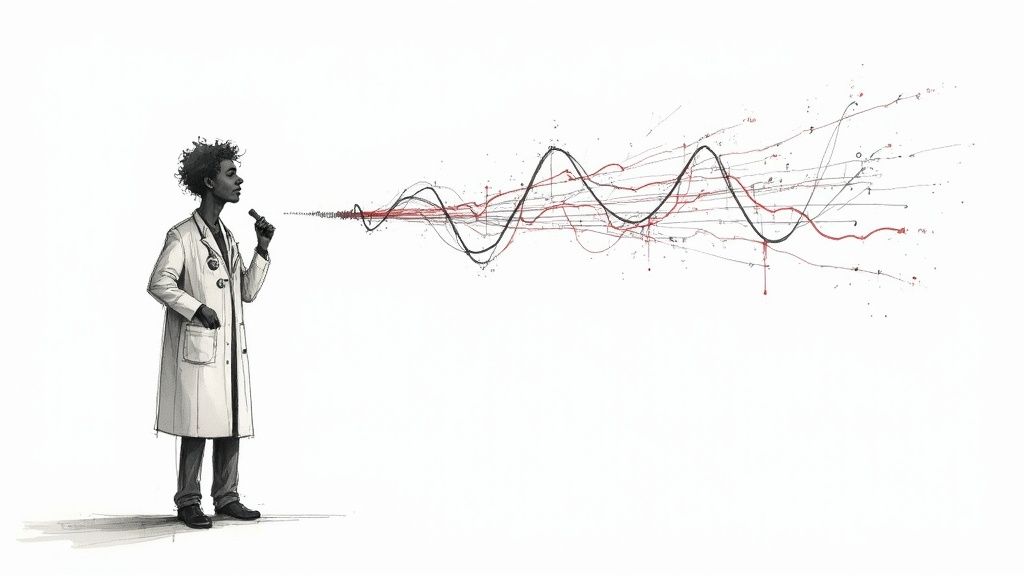
Freeing Clinicians from Administrative Burdens
One of the most significant wins for generative AI is in clinical documentation. For years, doctors have been drowning in paperwork, often spending more time typing up notes than actually talking to their patients. That’s where AI-powered ambient scribes are making a huge difference.
These tools simply listen to the natural conversation between a doctor and patient, then intelligently pull out the medically relevant details. The AI drafts a complete clinical note, formatted correctly and ready for the physician to quickly review and approve. This kind of workflow automation is a direct counterpunch to physician burnout, giving doctors back precious time to focus on what matters most: their patients.
The adoption rate tells the story. A recent survey found that over half of top U.S. health systems are already seeing high success using AI for their documentation. This rapid uptake is similar to how technologies like CT and MRI became standard practice, proving the industry is ready for powerful, helpful tools. For a deeper dive, you can explore detailed findings on AI's market readiness in healthcare.
Accelerating the Pace of Drug Discovery
Outside the clinic, generative AI is shaking things up in the world of pharmaceutical research. Bringing a new drug to market is a notoriously slow and costly marathon, often taking more than a decade and billions of dollars. Generative models are rewriting the rules by speeding up the crucial early stages.
Think of it this way: these AI systems can sift through massive biological datasets to do things like:
- Identify Novel Drug Candidates: They can generate new molecular structures from scratch that have a high likelihood of working against a specific disease.
- Predict Protein Structures: This is a fundamentally complex problem, but solving it is key to understanding disease and designing treatments.
- Optimize Clinical Trial Design: The AI can simulate how different patient groups might respond, helping researchers design smarter, more effective trials.
This allows scientists to test ideas that would have been impossible to explore manually, dramatically cutting down the time it takes to get from a promising idea to a viable drug candidate. You can see how this plays out across various real-world use cases.
Enhancing Medical Imaging and Diagnostics
Medical imaging—X-rays, CT scans, and MRIs—is another area getting a major boost from AI. While we've used predictive AI for years to spot potential issues in scans, generative AI brings a whole new set of skills to the table.
For example, it can take a low-resolution image and sharpen it, improving diagnostic clarity without forcing a patient to get another scan. Even more impressive, it can generate brand-new, high-quality synthetic medical images. This synthetic data is a goldmine for training better diagnostic AI models, especially for rare diseases where real-world examples are hard to come by. It’s a clever way to get around data privacy and availability issues, leading to more dependable diagnostic AI tools for business.
Generative AI in imaging doesn't replace the radiologist. It provides them with clearer images and more robust analytical tools, acting as a second set of eyes to improve diagnostic confidence and accuracy.
Personalizing Patient Engagement and Education
Finally, generative AI is changing how doctors and hospitals communicate with patients. Those generic, one-size-fits-all pamphlets and post-visit instructions? They often miss the mark, leading to confusion and patients not following their treatment plans.
Generative AI can create educational materials tailored to a specific person's diagnosis, medical history, and even reading level. It can draft personalized follow-up messages, answer common questions after an appointment, and provide health summaries that actually make sense. This customized communication helps patients understand their health better, empowering them to take an active role in their own care and leading to better outcomes. Of course, putting these tools into practice effectively requires a solid AI strategy consulting approach to ensure it's done right.
Unlocking Real-World Benefits in Healthcare
While the different ways to use generative AI are impressive, the real story is in the tangible results healthcare organizations are seeing. This isn't just about chasing the latest tech trend; it’s about making concrete improvements where it counts. The benefits of generative AI for healthcare really boil down to three critical areas that tackle some of the industry's most stubborn challenges.
First, you have a massive boost in operational efficiency. We all know administrative tasks can be a huge drain on time and money. AI-powered workflow automation is finally turning the tide by cutting down on clerical work and helping organizations make smarter use of their staff and facilities.
Second, the technology is directly improving patient outcomes. By helping clinicians make faster, more accurate diagnoses and create truly personalized treatment plans, AI reduces the risk of medical errors and ensures patients get care that’s actually right for them.
And finally, generative AI is putting medical innovation into overdrive. Research and development cycles that used to take years can now be compressed, speeding up the discovery of new drugs and life-saving therapies.
Pillar 1: Boosting Operational Efficiency
One of the first things you'll notice with generative AI is how much it cuts down on administrative headaches. It's no secret that doctors can spend up to two hours on paperwork for every one hour they spend with patients. Generative AI hits this problem head-on.
By taking over tasks like clinical documentation, insurance pre-authorizations, and routine patient scheduling, hospitals and clinics free up their staff to focus on what they were trained to do—care for people. This isn't a small adjustment; it’s a fundamental shift in how resources are allocated. Our AI Automation as a Service is built to find and automate these repetitive tasks, which leads to real cost savings and helps combat the rampant problem of employee burnout.
This efficiency boost goes beyond just one person's to-do list. AI models can look at all the operational data across a hospital to predict patient flow, manage beds more effectively, and streamline surgical schedules. The result is a healthcare system that runs more smoothly, with shorter wait times and resources that are always where they need to be.
Pillar 2: Elevating Patient Outcomes
Beyond making things run better, the real goal of any healthcare technology is to improve people's health. Generative AI is making a huge difference here by giving clinicians a powerful co-pilot in the diagnostic process, helping them spot diseases earlier and with much greater accuracy.
Think about it: AI can sift through a patient's entire medical history, lab results, and the latest medical research in seconds to suggest potential diagnoses a busy doctor might not have considered.
It's also incredible at creating personalized treatment plans. Instead of just following a standard protocol, AI can analyze a patient's unique genetic profile, lifestyle, and other health conditions to recommend the most effective treatment. That level of personalization just wasn't possible to deliver at scale before now.
By synthesizing complex patient data into actionable insights, generative AI acts as a decision-support tool. It empowers clinicians with a deeper understanding of each case, helping to reduce diagnostic errors and improve the overall quality and safety of care.
Pillar 3: Accelerating Medical Innovation
The third pillar is where things get truly exciting for the future. Generative AI is radically shortening the timeline for medical research and drug discovery. It can dream up entirely new molecules, predict how well they might work, and even simulate early-stage clinical trials, letting researchers test more ideas in a fraction of the time.
This speed is a total game-changer. It means new life-saving drugs and therapies can get from the lab to the patient's bedside faster than we ever thought possible. For any organization wanting to lead the way, a clear plan is key. That often starts with a Custom AI Strategy report to pinpoint the most promising paths for research and investment.
To make this all a bit more concrete, let's look at how these changes play out in day-to-day healthcare work.
Traditional vs. AI-Powered Healthcare Processes
The table below shows the practical difference generative AI makes in a few common healthcare workflows. It’s a simple "before and after" snapshot that shows how the technology is improving speed, cost, and accuracy.
| Healthcare Process | Traditional Method | Generative AI-Enhanced Method |
|---|---|---|
| Clinical Documentation | Manual note-taking and typing, consuming hours of physician time. | Ambient scribe listens to conversations and auto-drafts notes in minutes. |
| Patient Communication | Generic, one-size-fits-all pamphlets and follow-up emails. | Hyper-personalized educational materials and discharge summaries. |
| Drug Discovery | Slow, manual screening of thousands of potential compounds. | AI models generate and test novel molecular structures virtually. |
| Diagnostic Imaging | Radiologist manually reviews scans, relying solely on human interpretation. | AI enhances image clarity and flags potential areas of concern for review. |
As you can see, the theme here isn't replacement—it's augmentation. The goal isn't to replace skilled professionals but to supercharge their abilities, making them faster, more accurate, and ultimately more effective. This is the real value of bringing generative AI for healthcare into the fold.
Facing the Hurdles: Ethical and Technical Challenges
Bringing a technology as powerful as generative AI into healthcare isn't a simple plug-and-play operation. While the potential upside is enormous, getting there means carefully navigating a minefield of ethical, technical, and regulatory challenges. If we want to build systems that are not just effective but also trustworthy, we have to tackle these issues head-on.
It all starts with knowing what you’re up against. The journey often begins by understanding the full scope of potential issues. Expert AI strategy consulting can illuminate these challenges, ensuring that your organization is prepared from day one. This initial planning is critical for long-term success.
Protecting Patient Data and Ensuring Compliance
Let's start with the most obvious and critical issue: data privacy. In healthcare, patient information is sacred, and protecting it is an absolute must. Any generative AI tool has to comply with strict regulations like the Health Insurance Portability and Accountability Act (HIPAA), which sets the rules for handling Protected Health Information (PHI).
This isn't just a suggestion; it's a legal and ethical mandate. It means that every step of the AI process—from the data it's fed, to how it processes that information, to the final output—must be locked down. We're talking about heavy-duty encryption, strict access controls, and crystal-clear data governance policies. Organizations have to ask the tough questions: Where is our data living? Who can see it? What, exactly, is the model learning from it? A well-defined Custom AI Strategy report is often the first step to mapping out these compliance requirements.
The Challenge of Algorithmic Bias
Here’s a risk that keeps ethicists up at night: algorithmic bias. AI models are only as good as the data they learn from. If that data reflects existing biases in healthcare—and it almost always does—the AI will learn those same biases and can even make them worse.
For example, if an AI is trained on clinical data that predominantly comes from one demographic group, its diagnostic insights or treatment plans might be far less accurate for underrepresented populations. This isn't a theoretical problem. It's a real-world risk that could deepen existing health disparities, leading to worse outcomes for entire communities.
Fighting this requires a very deliberate effort:
- Audit Your Data: Before you even start training, comb through your datasets to find and address demographic gaps or historical skews.
- Test for Fairness: Don't just test for accuracy; constantly check the model’s performance across different patient groups to catch and fix biased results.
- Be Transparent: Know where your data came from and be ready to explain it. Accountability is key.
For organizations that are serious about equitable care, it's crucial to use tools that actively monitor and correct for bias. You can learn more about solutions designed to address these ethical considerations, like Alethic AI, by exploring how to embed fairness directly into your AI systems: https://www.ekipa.ai/products/alethic-ai
Demystifying the Black Box Problem
Another major hurdle is what we call the "black box" problem. Many complex AI models are incredibly good at finding answers, but they’re terrible at showing their work. It's often impossible to see how an AI reached a particular conclusion.
In a hospital or clinic, that’s a non-starter. If a doctor can't explain the logic behind an AI’s recommendation, it completely undermines clinical judgment and trust.
When a patient's health is on the line, "the computer said so" is not an acceptable explanation. Clinicians must be able to understand and validate the AI's logic to make responsible medical decisions.
The way forward is through explainable AI (XAI). These are models and techniques specifically designed to open up the black box and make the AI's decision-making process transparent. XAI allows a clinician to see the key factors the model weighed, transforming it from a mysterious oracle into a clear, auditable tool. By making explainability a priority, healthcare organizations can build the trust needed to make AI a true partner in patient care.
Your Practical AI Implementation Roadmap
So, you see the potential of generative AI in healthcare. But how do you get from a great idea to a tool that’s actually working in your clinic or hospital? The key is to think of it not as flipping a switch, but as a thoughtful, step-by-step journey. You start small, prove the value, and then scale up intelligently. This roadmap is designed for healthcare leaders who need a clear, actionable plan. It’s all about finding the right problems to solve, getting your data in order, and making sure your team is ready for what's next.
A smart rollout starts by zeroing in on high-impact use cases—those specific, nagging pain points where AI can make a real, measurable difference. Once you’ve picked your target, you can get down to the nitty-gritty of assessing data readiness, choosing the right tools, and launching focused pilot programs to test the waters.
Start with High-Impact Use Cases
Before you even think about technology, think about the problem. Where are the biggest logjams in your organization? What tasks are burning out your best clinicians? Where are patient outcomes not where they need to be?
Look for areas with clear, definable challenges. Good places to start often involve:
- The Grind of Administrative Tasks: We're talking about clinical note generation, endless prior authorization forms, or trying to optimize patient scheduling. Automating these tasks gives you a quick, tangible win.
- Wrangling Massive Amounts of Data: Think about a clinician trying to make a decision by sifting through years of patient history, lab results, and genomic data. AI can synthesize this information in seconds.
- Speeding Up Research and Development: Early-stage drug discovery and clinical trial design are notorious for their long timelines. AI is perfectly suited to find patterns and accelerate these processes.
Picking the right starting point is everything. A focused, iterative approach—identify, test, and then scale—is what builds momentum and gets everyone on board for the long haul.
Prepare Your Data and Infrastructure
Generative AI runs on data. Simple as that. Before you can launch any solution, you have to be absolutely sure your data is clean, secure, and accessible. This isn't something to gloss over; it requires a deep audit of your data sources, quality checks, and governance policies.
You absolutely need a rock-solid foundation for handling sensitive patient information that is fully HIPAA compliant. This means setting up secure data pipelines and deciding on the best infrastructure to run your AI models—whether that's on-premise servers, in the cloud, or a hybrid of the two.
This is where you also have to get serious about risk. This infographic lays out some of the core challenges you need to build a governance framework around.
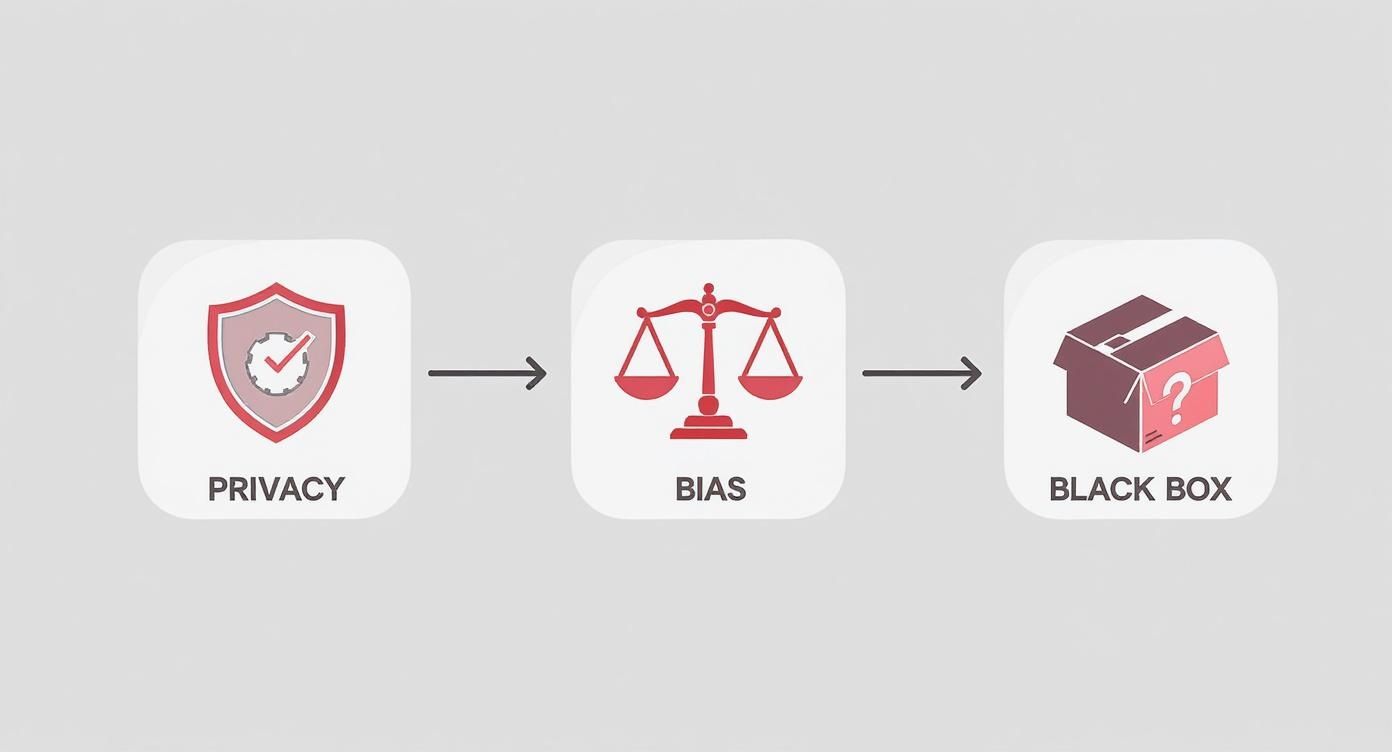
As you can see, things like data privacy, algorithmic bias, and the "black box" problem are all connected. You have to tackle them from the very beginning, not as an afterthought.
Run Pilot Programs and Measure Success
Whatever you do, don't try to roll out a massive new system across the entire organization at once. That's a recipe for disaster. Instead, launch small, controlled pilot programs centered on that high-impact use case you already identified. The real goal here is to test the technology in a real-world setting, get honest feedback from your clinicians, and measure what actually matters.
A pilot program's primary goal isn't just to see if the tech works, but to understand how it fits into your existing workflows and culture. It's an opportunity to learn and adapt before making a significant investment.
What should you track? Look at metrics like time saved on administrative work, a reduction in diagnostic errors, or even a jump in patient satisfaction scores. This hard data is what you’ll use to build the business case for expanding the program. Getting hands-on guidance can make all the difference here; our AI Product Development Workflow is designed to help teams move smoothly from a pilot to a full-scale production system.
This steady, proof-based adoption is exactly why the global AI in healthcare market is projected to shoot past $504 billion by 2032. This isn't just hype; it's being driven by AI's ability to fill critical gaps. We're facing a global shortage of healthcare workers, and 4.5 billion people lack access to essential services. With 57% of physicians believing AI will fundamentally change the industry, these tools are already being used to triage patients and spot early signs of disease.
Prioritize Change Management and Clinician Buy-In
Finally, never forget that technology is only half the battle. The other half—the more important half—is people. Getting buy-in from your doctors, nurses, and administrative staff isn't just a nice-to-have; it's a must-have.
Bring your clinicians into the conversation from day one. Let them help choose the tools and design the pilot programs. Be crystal clear about the "why" behind the change—how it will lighten their load, reduce burnout, and ultimately help them provide better care for their patients. A successful implementation isn't about tech support; it's about a smart change management strategy that ensures the new system is not only powerful but genuinely useful for the people on the front lines.
Shaping a Collaborative Future in Medicine
Let's be clear: the real promise of generative AI in healthcare isn't about replacing doctors and nurses. It's about empowering them. Think of it as giving medical professionals a new set of incredibly powerful tools that magnify their own expertise and, just as importantly, their ability to connect with patients. The potential to slash administrative burdens, accelerate life-saving research, and offer truly personalized care is immense.
But getting there requires a thoughtful partnership between human skill and artificial intelligence. This isn't something we can just switch on. It demands careful planning, rigorous ethical oversight, and an unwavering commitment to putting people first from day one. Building effective internal tooling that a clinician actually trusts and wants to use is just as crucial as the algorithm itself.
A Partnership Built on Trust
When done right, this partnership ensures technology serves the clinician, not the other way around. It's about freeing them from monotonous tasks so they can dedicate their time and energy to what they do best: complex problem-solving and building relationships with patients. For any healthcare organization looking to adopt these tools, having a solid game plan is everything. The goal is to build systems that are not just smart, but also transparent and dependable.
As we explored in our AI adoption guide, a successful rollout depends on a clear, step-by-step implementation that values both technical performance and getting your team on board. To get a better feel for what’s possible, you can check out a wide range of real-world use cases that bring these benefits to life.
The goal is not to create an automated healthcare system, but an augmented one. AI should handle the data, so humans can handle the care. This human-machine partnership is the key to unlocking a better future for medicine.
We believe in exploring these powerful technologies responsibly. For any organization ready to move from idea to implementation, having the right guidance can make all the difference. To start building your AI-powered future and set your team up for success, get in touch with our expert team. Let’s build the future of healthcare together.
Frequently Asked Questions
It's natural to have questions when exploring a technology as significant as generative AI in healthcare. Let's tackle some of the most common ones to give you a clearer picture.
How Is Patient Data Kept Private with Generative AI?
This is, without a doubt, one of the most critical questions. Protecting patient data is non-negotiable, and it's handled with multiple layers of security. First and foremost, any reputable system operates under strict HIPAA compliance.
On top of that, powerful techniques like data anonymization and de-identification are used. This means personally identifiable information is stripped away before the data ever reaches an AI model. Healthcare systems also have the option to run these models on their own private servers, keeping everything behind their existing firewalls. When you're evaluating any AI partner, make sure they can show you proof of their security protocols, preferably from an independent audit. It’s the only way to ensure these powerful AI solutions are operating inside a secure digital environment.
What's the Difference Between Generative and Predictive AI in Medicine?
It's a great question because they sound similar but do very different jobs. The easiest way to think about it is to imagine them as two different specialists on a medical team.
- Predictive AI is the forecaster. It sifts through existing data to predict a future outcome. Think of it identifying which patients are at high risk for sepsis or flagging a suspicious area on a mammogram that might be cancerous. It’s all about classification and probability.
- Generative AI is the creator. Instead of just analyzing data, it produces something entirely new. It could, for instance, listen to a patient visit and draft a perfect clinical note, design a unique molecular structure for a new drug, or write personalized discharge instructions tailored to a patient's specific condition.
So, in a nutshell, predictive AI finds the needle in the haystack. Generative AI builds a whole new haystack.
What Are the First Steps for a Hospital to Adopt Generative AI?
The key is to start small and think strategically. You don't want to boil the ocean.
A much better approach is to pinpoint a single, high-impact problem where AI can deliver a clear, measurable win. A perfect example is tackling physician burnout by automating clinical documentation. Once you have a target, assemble a small, dedicated team with people from clinical, IT, and administrative departments.
Then, launch a focused pilot program. Test the technology in a controlled environment and track specific metrics—things like time saved per physician or a reduction in documentation errors. The market for these tools is already proving their value. AI-powered ambient scribes, for example, have exploded into a $600 million market, seeing a 2.4x increase year-over-year. That’s because doctors often spend one hour on paperwork for every five hours of actual patient care, a massive drain on resources. You can get a deeper look at the AI in healthcare market here.
A successful pilot gives you the hard data and the internal support you need to confidently expand the initiative.
At Ekipa AI, we help you move from simply talking about AI to actually getting results. Our platform gives you a clear roadmap to find and execute on the most valuable AI opportunities, all without the long timelines and high costs of traditional consulting. Discover your AI opportunities with Ekipa today.

